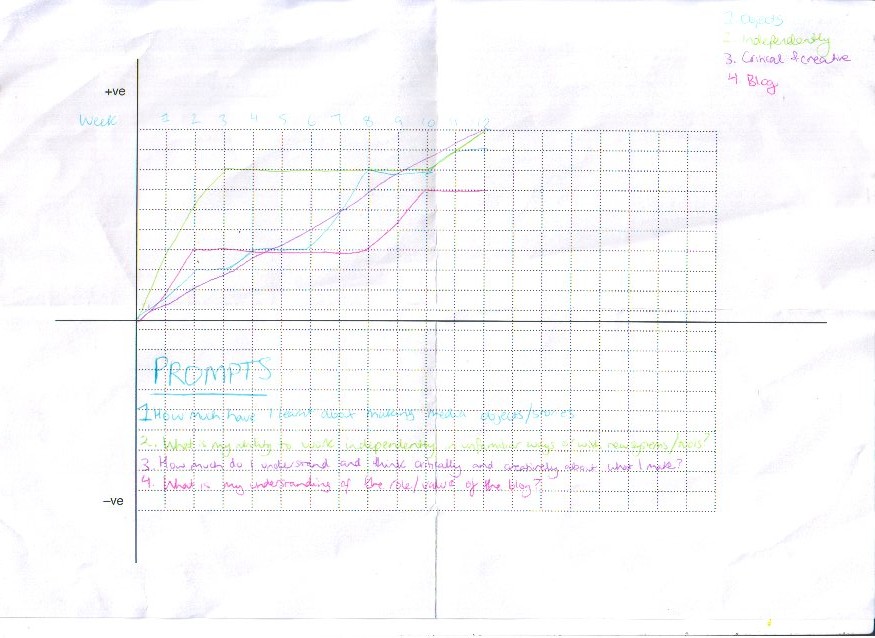So media one is over. It was one hell of a journey, from the highs to the lows, but I feel like I really learned a lot and I wouldn’t take it back for one second. (Okay, I totally ripped that off MasterChef.)
Seriously, though, I did learn a lot – so much that I put it in a graph! (One day I will escape maths.) It’s a great launching pad from which I can explain my learning process throughout the semester.
Let’s start with prompt one, which rises relatively steadily over the weeks. The plateaus are the weeks in between our assessments, because I found the moments I learnt the most about creating media objects were when I was practically doing it. The feedback process as well as my own investigation into new film-making techniques allowed me to learn about the media-making process. However, it’s important to note that it wasn’t just the practical elements that helped me learn about the media-making process. When we had guest lecturer Adrian Miles come and talk to us, he mentioned that what separated us as uni students from others in more hands-on courses was our understanding of the theory behind the practice. Thus, I’ve decided to link in this blog I did about Lost in La Mancha. While it’s about something from my textual crossings course, I reflected upon our lectorial on collaboration and thus media-making practice.
As for prompt two, there is a big spike at the start of the semester because that was when I was coming to grips with the key theoretical concepts of the course. It was a steep learning curve for me to rethink my definition of ‘media’ and look at it in a whole new light. So for this section, I’ll link in one of my earliest posts, media girl in a media world. Based on an in-lectorial exercise, this made me think a lot about the importance of media in the world around me.
Thirdly, we have creative and critical thinking about my own media work. This increased evenly throughout the semester, as I found that not only did the feedback from the assessments help me think about my own work, but I could also apply just about every theoretical concept I learnt in the lectorials to my work as well. That’s why for this section I’ve decided to link in my last post, the reflection on our group assessment. I could have chosen an earlier assessment, but I feel this last post, being so late in the semester, reflects a wider variety of the skills I have learnt when it comes to assessing my own work.
Finally, we come to the blog. There is a big spike at the start of the semester, because I felt the blog helped me process the initial big concepts to which I was being introduced. The second spike at the end of the semester was when I started to really get a handle on some of the concepts I was learning and started to really enjoy exploring the complex ideas in all my classes. So, my two final blog posts are both ones I enjoyed writing, because I was able to connect ideas learnt in media to other topics. In Pretty in Pink, I was able to discuss the concept of semiotics within the context of my own life and beliefs. In Remix, I was able to link one of Daniel Binns’ lectures to some work I’d found really interesting in textual crossings.
Well that, as they say, is all, folks. Have a great break (or winter, if you’re not a bludgy uni student like me but an actual working stiff). See you next semester!

